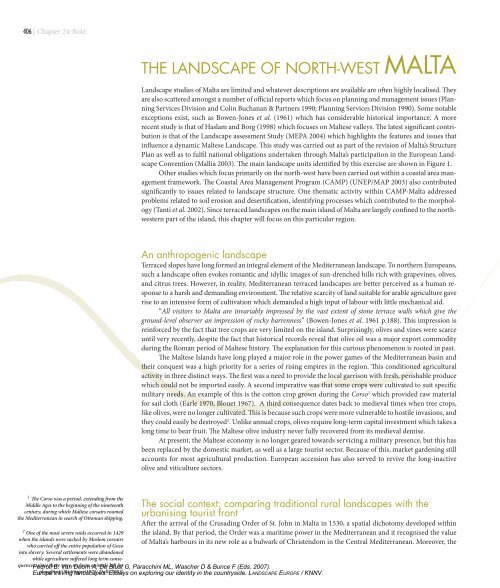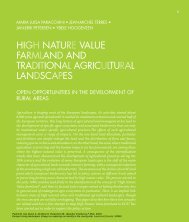The Terraced landscapes of The MalTese Islands - Landscape Europe
The Terraced landscapes of The MalTese Islands - Landscape Europe
The Terraced landscapes of The MalTese Islands - Landscape Europe
You also want an ePaper? Increase the reach of your titles
YUMPU automatically turns print PDFs into web optimized ePapers that Google loves.
06 | Chapter 24: Rolé<br />
1 <strong>The</strong> Corso was a period, extending from the<br />
Middle Ages to the beginning <strong>of</strong> the nineteenth<br />
century, during which Maltese corsairs roamed<br />
the Mediterranean in search <strong>of</strong> Ottoman shipping.<br />
2<br />
One <strong>of</strong> the most severe raids occurred in 1429<br />
when the islands were sacked by Moslem corsairs<br />
who carried <strong>of</strong>f the entire population <strong>of</strong> Gozo<br />
into slavery. Several settlements were abandoned<br />
while agriculture suffered long term consequences,<br />
since there were no farm animals left for<br />
ploughing (Wettinger 1975, Dalli 2002)<br />
<strong>The</strong> landscape <strong>of</strong> norTh-wesT MalTa<br />
<strong>Landscape</strong> studies <strong>of</strong> Malta are limited and whatever descriptions are available are <strong>of</strong>ten highly localised. <strong>The</strong>y<br />
are also scattered amongst a number <strong>of</strong> <strong>of</strong>ficial reports which focus on planning and management issues (Planning<br />
Services Division and Colin Buchanan & Partners 1990; Planning Services Division 1990). Some notable<br />
exceptions exist, such as Bowen-Jones et al. (1961) which has considerable historical importance. A more<br />
recent study is that <strong>of</strong> Haslam and Borg (1998) which focuses on Maltese valleys. <strong>The</strong> latest significant contribution<br />
is that <strong>of</strong> the <strong>Landscape</strong> assessment Study (MEPA 2004) which highlights the features and issues that<br />
influence a dynamic Maltese <strong>Landscape</strong>. This study was carried out as part <strong>of</strong> the revision <strong>of</strong> Malta’s Structure<br />
Plan as well as to fulfil national obligations undertaken through Malta’s participation in the <strong>Europe</strong>an <strong>Landscape</strong><br />
Convention (Mallia 2003). <strong>The</strong> main landscape units identified by this exercise are shown in Figure 1.<br />
Other studies which focus primarily on the north-west have been carried out within a coastal area management<br />
framework. <strong>The</strong> Coastal Area Management Program (CAMP) (UNEP/MAP 2003) also contributed<br />
significantly to issues related to landscape structure. One thematic activity within CAMP-Malta addressed<br />
problems related to soil erosion and desertification, identifying processes which contributed to the morphology<br />
(Tanti et al. 2002). Since terraced <strong>landscapes</strong> on the main island <strong>of</strong> Malta are largely confined to the northwestern<br />
part <strong>of</strong> the island, this chapter will focus on this particular region.<br />
an anthropogenic landscape<br />
<strong>Terraced</strong> slopes have long formed an integral element <strong>of</strong> the Mediterranean landscape. To northern <strong>Europe</strong>ans,<br />
such a landscape <strong>of</strong>ten evokes romantic and idyllic images <strong>of</strong> sun-drenched hills rich with grapevines, olives,<br />
and citrus trees. However, in reality, Mediterranean terraced <strong>landscapes</strong> are better perceived as a human response<br />
to a harsh and demanding environment. <strong>The</strong> relative scarcity <strong>of</strong> land suitable for arable agriculture gave<br />
rise to an intensive form <strong>of</strong> cultivation which demanded a high input <strong>of</strong> labour with little mechanical aid.<br />
“All visitors to Malta are invariably impressed by the vast extent <strong>of</strong> stone terrace walls which give the<br />
ground-level observer an impression <strong>of</strong> rocky barrenness” (Bowen-Jones et al. 1961 p.188). This impression is<br />
reinforced by the fact that tree crops are very limited on the island. Surprisingly, olives and vines were scarce<br />
until very recently, despite the fact that historical records reveal that olive oil was a major export commodity<br />
during the Roman period <strong>of</strong> Maltese history. <strong>The</strong> explanation for this curious phenomenon is rooted in past.<br />
<strong>The</strong> Maltese <strong>Islands</strong> have long played a major role in the power games <strong>of</strong> the Mediterranean basin and<br />
their conquest was a high priority for a series <strong>of</strong> rising empires in the region. This conditioned agricultural<br />
activity in three distinct ways. <strong>The</strong> first was a need to provide the local garrison with fresh, perishable produce<br />
which could not be imported easily. A second imperative was that some crops were cultivated to suit specific<br />
military needs. An example <strong>of</strong> this is the cotton crop grown during the Corso 1 which provided raw material<br />
for sail cloth (Earle 1970, Blouet 1967). A third consequence dates back to medieval times when tree crops,<br />
like olives, were no longer cultivated. This is because such crops were more vulnerable to hostile invasions, and<br />
they could easily be destroyed 2 . Unlike annual crops, olives require long-term capital investment which takes a<br />
long time to bear fruit. <strong>The</strong> Maltese olive industry never fully recovered from its medieval demise.<br />
At present, the Maltese economy is no longer geared towards servicing a military presence, but this has<br />
been replaced by the domestic market, as well as a large tourist sector. Because <strong>of</strong> this, market gardening still<br />
accounts for most agricultural production. <strong>Europe</strong>an accession has also served to revive the long-inactive<br />
olive and viticulture sectors.<br />
<strong>The</strong> social context: comparing traditional rural <strong>landscapes</strong> with the<br />
urbanising tourist front<br />
After the arrival <strong>of</strong> the Crusading Order <strong>of</strong> St. John in Malta in 1530, a spatial dichotomy developed within<br />
the island. By that period, the Order was a maritime power in the Mediterranean and it recognised the value<br />
<strong>of</strong> Malta’s harbours in its new role as a bulwark <strong>of</strong> Christendom in the Central Mediterranean. Moreover, the<br />
Pedroli B, Van Doorn A, De Blust G, Paracchini ML, Wascher D & Bunce F (Eds. 2007).<br />
<strong>Europe</strong>’s living <strong>landscapes</strong>. Essays on exploring our identity in the countryside. LANDSCAPE EUROPE / KNNV.




